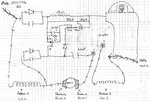electricboy
Newbie level 6
Hi,
I finally found a way to brake dynamically a drill and i found it on a circular saw.
I've drawn the electrical scheme of its brake which work with the drill (both the coils and the rotor are the universal motor).
The problem is that I want to resize the componant to make it brake faster.But I dont fully understand of this brake work.
Can anybody enlight me?
I finally found a way to brake dynamically a drill and i found it on a circular saw.
I've drawn the electrical scheme of its brake which work with the drill (both the coils and the rotor are the universal motor).
The problem is that I want to resize the componant to make it brake faster.But I dont fully understand of this brake work.
Can anybody enlight me?
